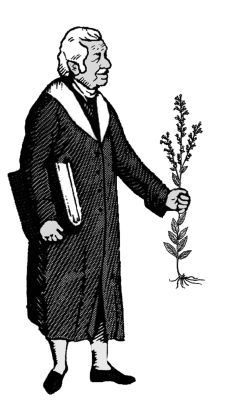Change of Seasons
Published: Wed, 09/15/21


Sponsored by The School of Natural Healing & Christopher Publications
September 15, 2021
Change of Seasons Jo Francks, M.H.

As we go from summer to autumn we feel the change in the air, the leaves lose their green luster and take on a shade of gold to brilliant red and eventually fall to the earth to become a blanket of mulch and protection to the soil through the cold winter. Gardens are coming to an end of the bounteous gifts of life-giving food. Kids go back to school and parents are either elated or are missing them. Emotions can be fluctuating as much as the temperature because of the many changes that we are facing.
This can be a time to take a look at the herbs that can help with those fluctuating emotions.
Nervine herbs can be helpful to regulate and rebuild the nervous system. For overall feelings of stress, my favorite herb is valerian. It can be taken when nerves are shot and 20 minutes later you can be feeling normal again. It works that fast. It may be a good idea to take it with peppermint or another mild stimulating herb if you don’t have time for a nap. Valerian is safe for children and can be used to help them calm down especially through an illness or to help them sleep at night. Other nervine herbs to consider are skullcap, chamomile, or passion flower. Dr. Christopher’s Relax-Eze formula combines many herbs to work in synergy for the nervous system.
Adaptogen herbs help regulate the immune system and help your body adapt to changes going on in your life and to stressful situations. Back to school, loss of a job, divorce, death of a loved one, or even a change of season, are situations one would consider using an adaptogen for. A well known adaptogen is ginseng. It has a long history of use for good reason. It strengthens the life force energy of the body and builds Chi. Adaptogens affect and strengthen the endocrine system which is responsible for hormone production. If hormones are out of balance, it may be beneficial to look at adaptogens to see if they can help. Some other common adaptogens are ashwagandha, eleuthero, holy basil, licorice root and shiitake mushrooms.
Another category of herbs that are useful through the seasonal change is herbs for the heart and circulatory system. Hawthorn is the first to come to mind when thinking of heart herbs and cayenne for circulation. The heart is the most important muscle in the body and unlike the rest of our muscles, it never stops its action. Keeping the heart healthy is a number one consideration for good health. This is done by eating a healthy diet, exercising regularly, reducing stress and using herbs that keep the heart healthy. Other herbs to consider for the heart are motherwort if you are having palpitations, and valerian which strengthens the heart beat without increasing the heart rate. Ginger and ginkgo help increase circulation.
As the seasons change keep in mind all the wonderful herbs that are available to assist the body in a gentle way to help it move into the fall season.
Jo Francks is a Master Herbalist working at the School of Natural Healing
Printable Version: http://herballegacy.com
If you missed an article be sure to visit http://www.herballegacy.com and click on Articles. Also, take advantage of David Christopher's Radio Show (see Resource Links below for more information).
A Healthier You Radio show is back!
Listen live every Monday morning at 11:30 Mountain Time.
Click here for the link to listen to our live show
The School of Natural Healing is on Youtube!
You can check it out here!

3 Tbsp Olive Oil
1 onion - chopped
2 lb. ripe tomatoes
1 garlic clove, roughly chopped
3 cups vegetable stock
2 Tbsp shredded fresh basil or 2 tsp dried basil
⅔ cup coconut milk or other non-dairy milk
Salt and ground black pepper
Whole basil leaves, to garnish
- Heat Olive oil in a large pan. Add onions and cook gently for about 5 minutes, stirring until the onion is softened but not brown, then add chopped tomatoes and garlic.
- Add the vegetable stock (and dried basil if you are using dry instead of fresh) and heat to just below boiling point, then either cook on the stove on low for 2-3 hours, or pour slowly into a crockpot and cook on low for 3-4 hours, until tomatoes are tender
- Let the soup cool for a few minutes, then ladle into a blender or food processor and process until smooth.
- Pour the soup into a pan, add coconut milk and shredded fresh basil (if you are using fresh instead of dried basil).
- Heat on low, not allowing the soup to reach boiling point. Check the consistency and add more vegetable stock if needed.
- Season with salt and pepper, pour into bowls, garnish with fresh basil leaves, and serve.
Recipe by Tara Eyre
Printable Version: http://herballegacy.com
Herbal Resource Links
- Herbal Legacy - http://www.herballegacy.com - Our free information website
- The School of Natural Healing - http://www.snh.cc - Quality Education since 1953
- Christopher Publications - http://www.christopherpublications.com - Dr. Christopher's books and more
- A Healthier You Radio Show - http://www.ahealthieryouradio.com - Free weekly radio show
The School of Natural Healing: http://www.snh.cc
Christopher Publications: http://www.christopherpublications.com
NOTICE: All information in this newsletter is given out as information only and is not intended to diagnose or prescribe. For our official Disclaimer, Biological Individuality, Important Notice & Terms of Use please see: http://www.herballegacy.com/Disclaimer.html
This newsletter is sent by permission only - you can unsubscribe quickly and easily by clicking the link below.
.